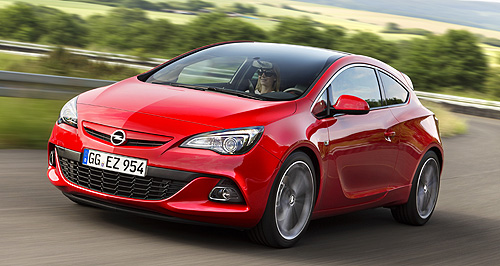Future models - Opel - Astra - BiTurbo CDTIOpel goes gunning for Golf GTDTwo up: The Opel Astra BiTurbo CDTI is not slated for Australian sale, at least for now. 143kW BiTurbo diesel Opel Astra set to eclipse hot diesel Golf in power, performance2 Aug 2012 OPEL has grafted its grunty twin-turbo 2.0-litre diesel engine from the Insignia into its smaller Astra range in Europe, creating a hot diesel small car with more power and torque than Volkswagen’s benchmark Golf GTD. With 143kW of power and 400Nm of torque, the Astra BiTurbo CDTI has 18kW more power than the Golf GTD, as well as a significant 50Nm of extra torque. At this stage, Opel Australia has no firm plans to add the variant to its newly launched range in this market, although head of marketing and public relations Michelle Lang indicated that it was on the company’s wish list when she told GoAuto: “I think it would be a fantastic boost to the Astra range, but it’s not part of our plans at this stage.” Opel will launch in Australia with a 2.0-litre single-turbo diesel in Astra alongside a pair of four-cylinder turbo-petrol variants, in 1.4 litre and 1.6 litre sizes. Even the standard diesel engine offered in the Astra launch line-up packs a healthy 121kW of power and 350Nm of torque, only 4kW short of Golf GTD’s 125kW peak power and matching the GTD’s torque. However, VW is set to reveal its new seventh-generation Golf at the Paris motor show next month, and it might not stick with the same GTD engine that is also used in the Skoda Octavia RS TDI in Australia. The Opel BiTurbo variant is available in all three Astra body styles – five-door hatch, Sports Tourer wagon and GTC three-door hatch – pushing the five-door variant to a top speed of 226km/h, making it the fastest diesel Astra ever. No 0-100km/h sprint figures have been released, but European news outlets speculate it should be faster than the Golf GTD’s 8.0 seconds. The standard 2.0D Astra does the dash in 9.0 seconds in manual form, and 9.2 seconds with the six-speed automatic transmission. At the heart of the BiTurbo’s extra performance are its dual turbochargers – one large and one small, working separately or together. Opel says the smaller turbo comes on stream quickly at low speeds, helping to eliminate turbo lag. About 320Nm of torque – or about 80 per cent – is said to be on tap at just 1250rpm, while the full 400Nm is available between 1750 and 2500rpm. In the mid-range, both turbochargers operate together, with the larger turbocharger pre-compressing the intake air, before it is fully compressed in the smaller one. The big turbo takes over from about 3000rpm. To help put the performance to the tarmac through the front wheels without armloads of torque steer, Astras equipped with this engine get Opel’s HyPerStrut front suspension system. As well, the BiTurbo models sit lower on stiffer springs, with handling also aided by stiffer springs and a revised rear-end roll rate. Despite the extra performance, the BiTurbo engine is just marginally less fuel efficient than the single-turbo unit. In the five-door hatch and Sports Tourer, the manual-equipped BiTurbo records a combined fuel test figure of 5.1 litres per 100km, compared with the standard diesel’s 4.7L/100km. The slippery GTC hatch BiTurbo is even more efficient, at 4.9L/100km. Opel makes no mention of transmission choices for the BiTurbo, so it probably will come exclusively with a six-speed manual. Because the engine bay packaging is tighter in Astra than Insignia, where the engine made its debut early this year, Opel engineers had to come up with a split intercooler design within one unit, instead of the two separate units in the larger car. To suit the BiTurbo CDTI’s sports pretensions, Opel applies a more aggressive body treatment with a fresh front fascia that melds the GTC’s sporty look with some new cues, including a bigger low air opening that merges with the side openings, separated partly by what the designers say is a “shark’s fin-shape” in body colour. Interestingly, Opel’s Australian-raised exterior chief designer, Niels Loeb, was responsible for secretly adding a shark design in the side of a plastic hinge for the Corsa’s glovebox as a tribute to his Australian heritage. Twin tailpipes have been added for affect in a modified rump design that Opel says gives the car a more muscular stance. Inside, BiTurbo variants get black trim with red highlights, including red contrast stitching, as well as a flat-bottomed steering wheel and red-edged floor mats. The BiTurbo gets a range of high-tech safety equipment yet to be offered on the new Opel range in Australia, including the second-generation Opel Eye front camera with enhanced traffic sign assistant (TSA II), lane-departure warning, following distance indication (FDI) and forward collision alert. A rear view camera is available in the Sports Tourer and five-door BiTurbo models. European customers can also opt for a unique panoramic windscreen that extends the front glass upwards to the middle of the car.  Read more |
Click to shareOpel modelsResearch Opel Motor industry news |

























Facebook Twitter Instagram